Last-Minute NYC Holiday Gift Guide 🎁
We’ve created a holiday gift guide with presents for the intrepid New Yorker that should arrive just in time—


The most unlikely attraction at Brooklyn’s Green-Wood Cemetery is the group of loud, colorful birds: the monk parrots of Argentina.
Situated at Brooklyn’s highest point, Green-Wood Cemetery is ideal for birds migrating along the Atlantic Flyway. With nearly 500 acres of fruit trees, elms and ponds, the cemetery offers a green respite from the surrounding urban area. Plus, given the state of its residents, the grounds are usually pretty quiet. Birders at Green-Wood can expect to see herons, egrets, hawks, and killdeer, among dozens of other birds. The most surprising bird inhabiting the cemetery, though, is the monk parrot.
Monk parrots (myiopsitta monachus) appear as a shock of lime green against the cemetery’s lush landscape. About eleven inches long and a bit stocky in stature, their green is complemented by grey “hoods” of coloring over their forehead, cheeks, throat and breasts, hence the monk designation. Their wings are dark blue, and the tails have a hint of pink. Their song has been described as “raucous and harsh.” Their personalities are gregarious.
Like most other New Yorkers, the monk parrots are not originally from New York City. Like most other New Yorkers, they are immigrants. Monk parrots are native to Bolivia, Brazil, Paraguay and Uruguay. The parrots in Green-Wood Cemetery come from Argentina, or so says Steve Baldwin, of Brooklyn Parrots.
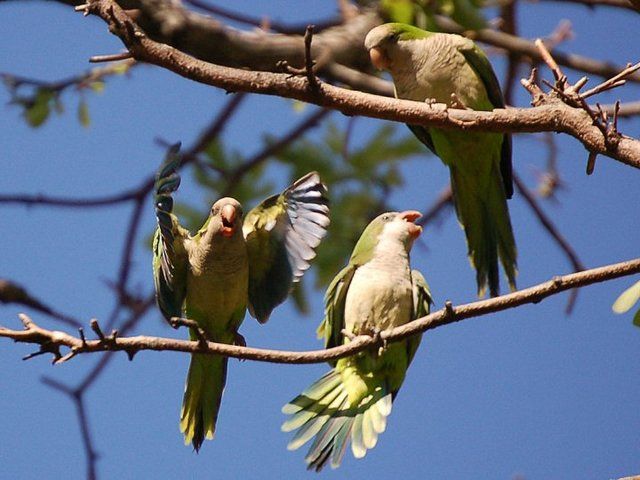
Steve Baldwin is the self-appointed expert on the monk parrots of Green-Wood Cemetery. Baldwin is in his late 50s. He is tall and thin with white hair and glasses. He is also gregarious, with energetic and welcoming body language. Baldwin is not an ornithologist, however. He’s more of an enthusiast. He runs parrot ‘safaris’ at Green-Wood, and says the story of how these chatty birds found their way to Brooklyn goes back about 50 years.
In the 1950s, according to Baldwin, Argentina was looking to expand agricultural output in an attempt to modernize their economy. The country wanted to grow more food, specifically in places they had never grown food before. To the monk parrots of Argentina, this was initially a welcome development. Suddenly there was a lot more food, specifically in places there had not been any food before.
To the Argentine government, however, these birds were a nuisance, or more appropriately, a pestilence. The economy would never grow if the food wouldn’t first grow. And the food would never grow so long as the parrots were around.
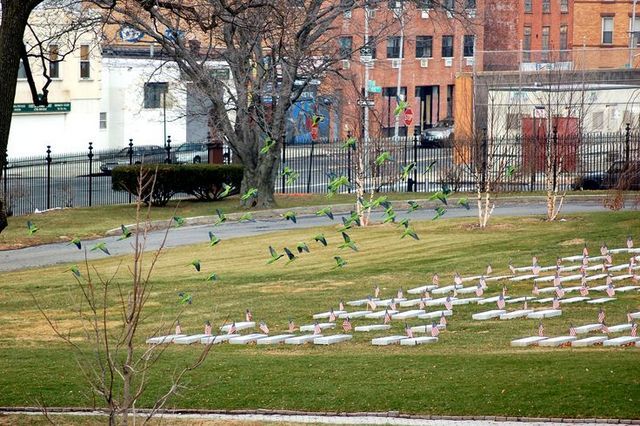
So the Argentine government decided to invest in bounty hunters: citizens, farmers, anyone with a gun. This crowd-sourced solution promised a small sum to anyone who killed a monk parrot and sent in the bird’s feet for verification. Despite the nearly half a million pairs of bird feet sent in for payment, this strategy proved ultimately unsuccessful. For one, the breadth of the parrot populations was larger than originally assumed. Secondly, the program was rife with fraud, with many ‘non-parrot’ feet being sent in for payment.
So Argentina went to Plan B: selling the birds. In the late 1960s the market for exotic birds in the United States was taking off as more and more people came to enjoy the parrots’ intelligence and sociability. Sensing an opportunity, some 60,000 of Argentina’s monk parrots were rounded up and sent to American pet shops. In 1968 alone, nearly 12,000 monk parrots were brought to the United States.
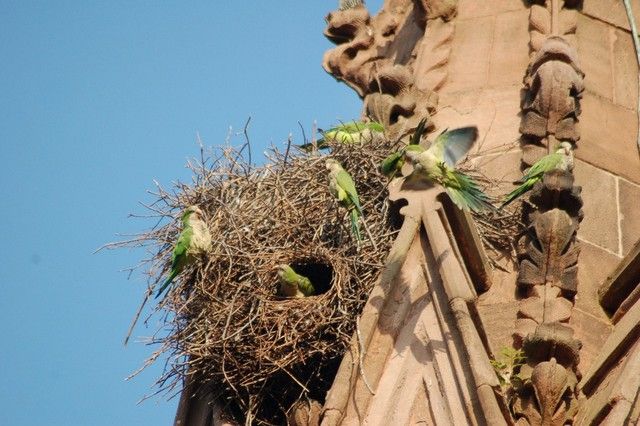
Exactly how the birds got from being on their way to pet shops to living in the wild in Green-Wood Cemetery, however, is a bit fuzzy.
The most popular version of the story says that an unmarked crate arrived at New York’s JFK Airport in 1967. A curious airport employee opened the mysterious crate to see what was inside. Suddenly, and with quite a flutter, the colorful birds escaped. A similar version states the “curious employee” was actually an individual with mafia ties looking to pilfer whatever was inside the crate.
Another theory says the “wild” birds are actually released pets. This story asserts that pet owners in New York City experienced buyer’s remorse with the chatty birds and simply released them out their windows. Still another version says they all flew away from a shuttered pet shop on Flatbush Avenue in Brooklyn.
Even if it’s not exactly clear how it happened, by the late 1960s the parrots had made their way to New York City. According to a report by New York City naturalist John Bull, nearly a dozen species of escaped parrots had been observed around New York City area in the early 1970s. The monk parrots, however, seem to be the only species hardy enough – or maybe just lucky – to survive the unforgiving New York City winters.
Unfortunately, like so many New Yorkers, the birds ran into problems with the neighbors. Concerned residents alerted the authorities. In turn, the authorities contacted the Argentine government to see what to do. Not surprisingly, Argentina strongly suggested killing all the birds.
So in 1973, a team of bird hunters hired by the U.S. government set out to shoot and kill all the parrots. The group was an interagency task force of state and federal agencies with the New York Department of Environmental Conservation in the lead. The Department of Agriculture was also involved. (It’s unclear who brought the firearms.) Quickly, about half of the pandemonium was killed, before the remaining parrots were found hiding on Rikers Island. According to Baldwin, the exterminators arrived at Rikers to finish the job, but were not allowed on the grounds due to a lack of permits. The next day, with their paperwork in order, the team returned only to find the birds gone.
From there the birds flew south to Brooklyn, to Green-Wood Cemetery, where they would make their new home. With no agriculture nearby to plague, and few living neighbors to complain, the parrots had found asylum at Green-Wood.
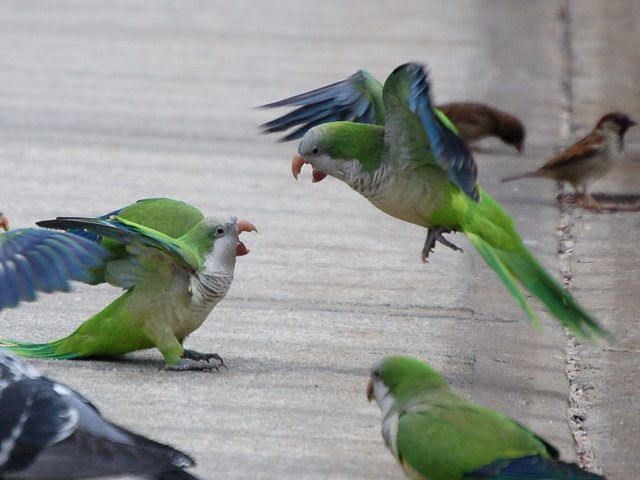
Years later, Steve Baldwin has found a sort of calling, leading his own flock of eager birders hoping to spot the colorful monk parrots. The safaris are not a full-time job for Steve. In fact, the tours are free. During the week, he works in marketing. However, on the first Saturday of every month, groups convene outside the cemetery gates in Brooklyn’s South Slope neighborhood, waiting for Steve to show them the parrots. The next event is on December 12th at Brooklyn College.
“It’s certainly not the most important issue in the world,” Baldwin concedes. “But it’s a nice feeling to know these animals are out there. Life is right here in New York City, too. There’s still magic here.”
Officially speaking, Green-Wood Cemetery has no official position on Steve or his safaris. According to Chelsea Dowell, Manager of Programs and Membership, Green-Wood is “thrilled” whenever people come to view the birds. “Green-Wood has always been a place where people enjoy nature,” says Dowell. “These birds are just one more facet of that.” And if in fact Steve is sneaking around with his unofficial safaris, it would be seen by Green-Wood as completely “sanctioned sneaking.”
On the safaris, the main attraction is the grand Gothic Revival archway lording over the cemetery’s entrance near 25th Street and 5th Avenue, where about 100 Monk Parrots have made their home. Richard Upjohn, who also designed Trinity Church on Wall Street in Lower Manhattan, designed the brownstone structure in 1863. The archway boasts countless eaves, nooks and crannies. In addition to thrilling architectural enthusiasts, they are also ideal for parrot nests.
Parrots are communal breeders. That means pairs of nesting parrots make their homes in larger groups. These nest complexes are akin to an apartment building, with up to a dozen parrot couples breeding and roosting within their individual chambers. Each ‘apartment’ has its own entranceway, though there is no common area.
In this small way, the monk parrots further mimic the immigrant experience of New York City: living in close quarters with their own kind, often at elevation, thousands of miles from home.
Hawks and crows pose a distinct threat to the parrots, but so, some might say, does the utility provider of New York City, ConEdison.
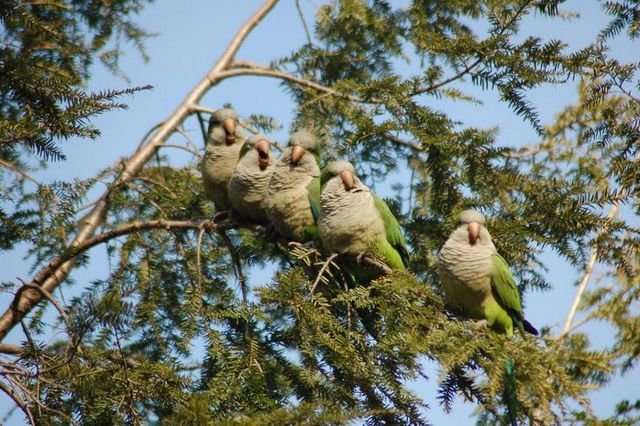
Nearby, where Gothic Revival archways can’t be found, the Monk Parrots have become quite fond of nesting on electrical transformers. The birds are drawn to the height and stability, not to mention the warmth. However, this has led to countless short-circuits, some localized blackouts and even fires. Con Edison has frequently had to disrupt these nests.
“I have trouble describing myself as an ‘animal rights’ person,” says Baldwin with regard to the transformer nests. “I see the point of view of the utilities company.”
But, at Green-Wood Cemetery, the birds can flourish, with only the occasional hawk or crow to discourage their efforts. Furthermore, the birds are bringing living people back to the cemetery. Cemeteries, by design, have a pretty solid business model, and enjoy a reliable customer stream. However, Green-Wood has run into some practical constraints. Namely, they’re running out of space for plots. The monk parrots, and the birders who come to appreciate them, represent a new model of attracting visitors to Green-Wood.
And so, in a cemetery of all places, the monk parrots are given a chance to live.
@untappedny Meet the unexpected residents of Green-Wood Cemetery! Did you know about the vibrant green parrots that call this historic place home? Uncover more secrets of NYC on UntappedNewYork.com #nyctiktok #secretsofnyc #brooklyn #greenwoodcemetery #history ♬ Positive background music such as play and games(1251730) - earbrojp
To Baldwin, this is quintessentially American. “They came in the same way most immigrants come in, right through the airport,” he says. “And what is the American Dream? I’d say it’s to be left alone. And that’s all these birds want, man. They just want to be left alone to do their thing. And if you take your knocks, you can keep your piece of the rock. Or at least part of Brooklyn… They’d never be able to get into Manhattan.”
Next, read about the catacombs at Green-Wood Cemetery and more.
Subscribe to our newsletter